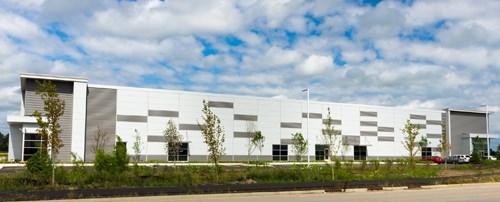The steadily growing list of IACMI resources
IACMI, the public-private composites consortium, is a little more than a year old and already has developed a strong collection of partnerships, facilities, equipment, software and material designed to help accelerate new technology development for the composites industry.

The just-completed Indiana Manufacturing Institute at Purdue University will house the IACMI Design, Modeling and Simulation Technology Area, which aims to integrate major composites design software platforms to make composites design more efficient and robust.
The (IACMI; Knoxville, Tennessee), the public-private consortium designed to accelerate development of composite design, materials and processing technologies, is proving a dynamic and active organization, revealing at its July 28 meeting at Purdue University (West Lafayette, Indiana) that it is quickly expanding its collection composites-related manufacturing resources.
Dale Brosius, chief commercialization officer at IACMI and ÂÌñÏ×ÆÞ columnist, outlined at the meeting a host of completed and in-process facilities and equipment being installed or build with or for the consortium. First on the list was the Indiana Manufacturing Institute, located in the Purdue Research Park, which was just completed and will house the IACMI Design, Modeling and Simulation Technology Area. This 30,000-ft2 space will be used, among other things, to work on integration of major composites design software platforms from suppliers such as ESI, Dassault Systèmes, Altair, digimat, Moldex3D, Convergent and AnalySwift. The facility will also offer some fabrication capabilities, including a fused deposition modeling (FDM) machine.
At the University of Tennessee (UT; Knoxville), and opening Aug. 22, is the UT-IACMI Fiber and Composites Manufacturing Facility (FCMF), an 8,000-ft2 facility for industry collaboration and experiential learning. It will facilitate concept-to-prototype manufacturing and features equipment/machinery for process modeling, CAD, long-fiber compression molding, injection molding, vacuum diaphragm forming, low-pressure resin transfer molding (LP-RTM), compression molding, sheet molding compound (SMC), tooling, physical and mechanical testing and non-destructive evaluation (NDE).
In Colorado, at the National Renewable Energy Laboratory (Boulder), and supported by the Colorado School of Mines and Colorado State University, IACMI is developing the Composites Manufacturing and Education Technology Center (CoMET). This 10,000-ft2 facility, adjacent to the NREL wind blade test facility, will be used to conduct manufacdture of full-scale wind blade components, including roots, tips, spar caps and shear webs. This facility, which is expected to open in October 2016, will offer infusion, pultrusion, prepreg, RTM and hand layup capabilities. It will also provide assembly, bonding, finishing, NDE, structural testing and workforce capabilities.
In Michigan, in the Detroit neighborhood called Corktown, IACMI is developing what is informally known as the Corktown Facility. More formally, it will serve as a research, development and manufacturing scale-up center for IACMI's Vehicles Technology Area (VTA). Spearheaded by Michigan State University, the Corktown Facility will be in a building shared with Lightweight Innovations for Tomorrow (LIFT), a consortium that emphasizes metals development. The IACMI portion of the facility will feature several large pieces of machinery, including a Milacron 3,315-ton injection molding machine, a Schuler 4,000-ton compression molding machine, a KraussMaffei high-pressure RTM (HP-RTM) machine and a prepregger being donated by TenCate. The IACMI Corktown Facility is expected to up and fully functional by early 2018.
Finally, as was reported recently, IACMI has formalized a partnership with the Composite Recycling Technology Center (CRTC) in Port Angeles, Washington. CRTC, in partnership with Peninsula College, is working to convert scap prepreg into a usable fiber, and the IACMI partnership is expected to help accelerate market development for such material.
Related Content
Proving thermoplastic composites match carbon fiber/epoxy performance in road bikes
CDCQ, LxSim, Addcomp and Argon 18 collaborate to optimize a carbon fiber/PA6 bike seat post, democratizing AFP and demonstrating materials and process for future designs and production.
Read MoreCrashworthiness testing of composites: A building block approach, Part 2
Following the previously discussed coupon-level testing element, subcomponent and component testing are the next steps in designing crashworthy composite structures.
Read MoreAurora reveals latest SPRINT X-Plane design concept
An Aurora and Boeing team advances its high-speed, vertical lift concept to the preliminary design phase, which features three lift fans, a more refined composite exterior and an uncrewed cockpit.
Read MoreTroubleshooting thermoplastic composite stamp forming
Understand the basic science of TPC stamp forming, a manufacturing process steadily gaining momentum in aerospace and mobility applications thanks to its rapid forming, short cycle times and automated methods.
Read MoreRead Next
Ultrasonic welding for in-space manufacturing of CFRTP
Agile Ultrasonics and NASA trial robotic-compatible carbon fiber-reinforced thermoplastic ultrasonic welding technology for space structures.
Read MoreScaling up, optimizing the flax fiber composite camper
Greenlander’s Sherpa RV cab, which is largely constructed from flax fiber/bio-epoxy sandwich panels, nears commercial production readiness and next-generation scale-up.
Read MoreCeramic matrix composites: Faster, cheaper, higher temperature
New players proliferate, increasing CMC materials and manufacturing capacity, novel processes and automation to meet demand for higher part volumes and performance.
Read More












